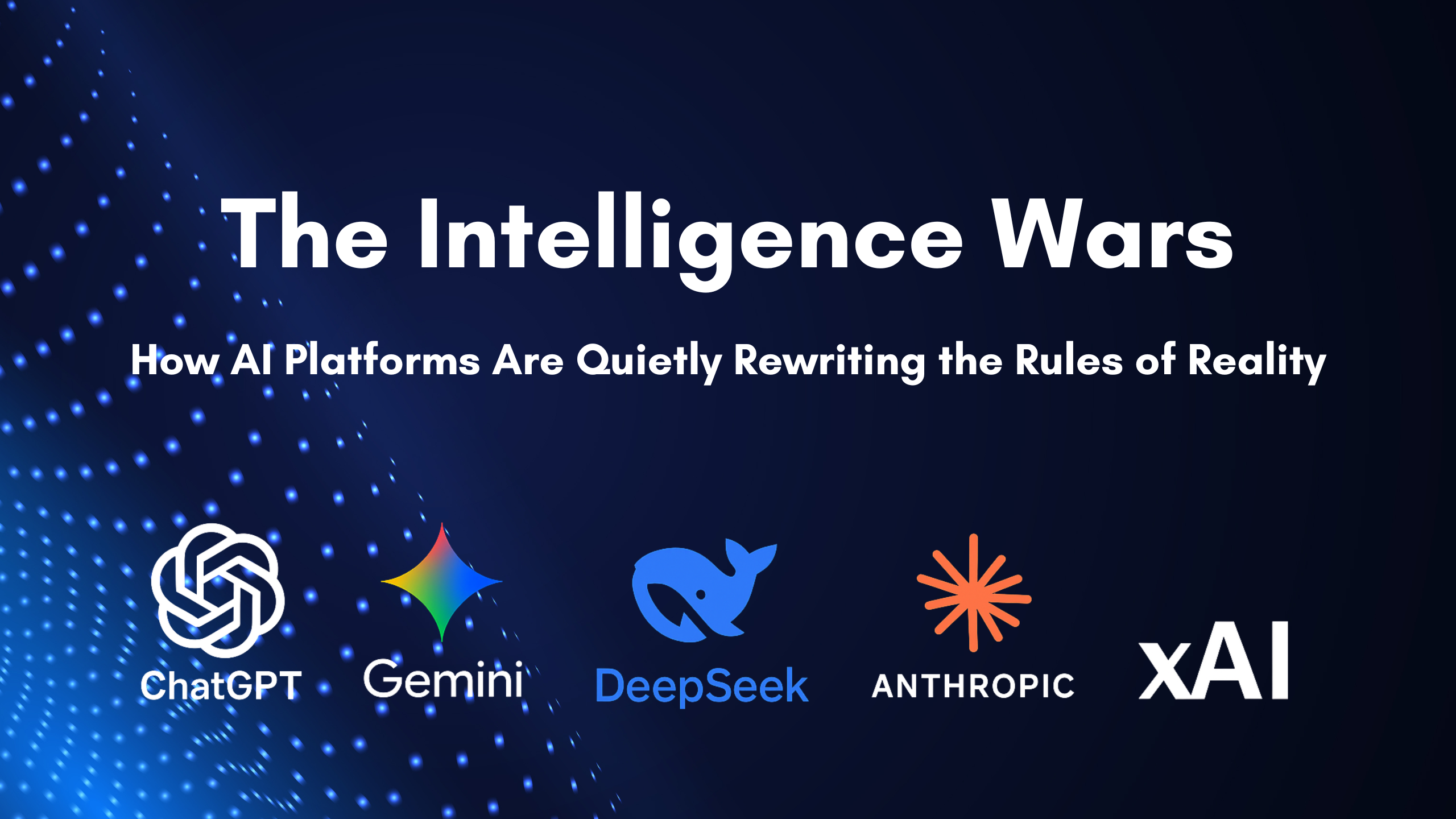Intelligence is no longer human-only. Artificial systems are now embedded in how we search, plan, learn, and act.
Technology no longer sits quietly in the background. It shapes how people speak, work, learn, make decisions, and even how they see themselves. It even assisted in the writing of this blog! The software we interact with is not only there to help; it also influences what we prioritise, how we solve problems, and what we consider to be true.
What you choose to use is no longer just a tool. It is a signal. A reflection of how you want to think, what kind of systems you want to support, and the kind of future you believe in.
That’s what makes this moment unusual. The current generation of intelligent platforms isn’t competing for features or speed. Each one is building something bigger: an operating system for how people move through the world.
This piece breaks down five of the most influential platforms shaping that shift: OpenAI, Gemini, DeepSeek, Claude, and Grok. These are not neutral services. They carry distinct values, trade-offs, and ideas about how decisions should be made. Looking at them side by side helps clarify where things are headed and what’s really at stake.
Let’s take a closer look.
ChatGPT by OpenAI: Powering How Work Gets Done
ChatGPT remains the most widely adopted conversational AI platform, with more than 700 million weekly users and deep integration across industries. In 2025, OpenAI has accelerated its development cycle. GPT-4o was released with built-in vision, voice, and lower latency. It allows users to interact in real time across modalities. A larger release, GPT-5, is in final tuning and will likely introduce agent-based task execution and long-term memory.
This is no longer just a chatbot. It is evolving into a digital operator capable of executing multi-step tasks across tools and devices.
AI Developments:
- GPT-4o launched with native image, audio, and text support
- Memory tools were introduced for continuity across sessions
- Study Mode rolled out to reduce misuse in academic settings
- GPT-5 is expected to introduce autonomy, planning, and decision execution
Pros:
- High energy, culturally reactive, and fast-moving
- Strong performance in real-time reasoning and benchmarks
- Integrated into large user platforms, including X, Tesla, and Telegram
- Multimodal capabilities, including text-to-video generation
Cons:
- High energy use
- Safety issues, including offensive, misleading, or biased outputs
- Known instability due to limited alignment controls
- Public staff departures and governance conflicts raise concerns about internal cohesion
- Lacks enterprise-grade reliability or regulatory trust
Gemini by Google: The AI That Wants to Disappear Into Everything
Gemini is Google’s response to OpenAI, but its strategy is different. Gemini is designed to become invisible. It integrates deeply into Gmail, Docs, Android, Chrome, and Search. It powers services without requiring direct input. The 2.5 version supports massive context windows and is deeply embedded into Google’s productivity suite.
Google is also investing in Project Astra, which is building AI agents that operate in the real world using sensors and live context. Gemini is not a chatbot. It is the ambient layer that powers actions without requiring permission or prompting.
AI Developments:
- Gemini 2.5 released with 2 million token memory
- Integrated into Android, Google Docs, Gmail, Calendar, and Chrome
- Project Astra prototype showcased a real-time camera and voice response
- Med-Gemini flagged for hallucination in clinical language scenarios
Pros:
- Deep integration across the Google ecosystem
- Best available memory span for complex or document-heavy tasks
- Multimodal by default, supports image, audio, and text
- Invisible UX suited for everyday tasks and summarisation
Cons:
- Functionality outside of Google services is limited
- Memory vulnerabilities reported in real-world demos
- Questions remain around data collection and search manipulation
DeepSeek (China): Open Performance in a Closed System
DeepSeek has emerged as one of the most disruptive platforms of 2025. It achieved GPT-4-level output using legacy Nvidia chips and released its models as open weights under an MIT license. This made DeepSeek the first high-performance LLM to offer full transparency and free deployment.
Its use has exploded across Asia, Latin America, and the Middle East. However, default filters around political content and alignment with Chinese government speech norms have drawn criticism and regulatory blocks in parts of Europe.
AI Developments:
- V3 model released with open weights and API-free access
- Adopted by Chinese banks, ed-tech platforms, and state applications
- Rapid adoption in countries prioritising data sovereignty
- Blocked from public sector use in Germany, Italy, and the Czech Republic
Pros:
- Fully open source, ideal for self-hosted deployment
- Training cost was significantly lower than Western rivals
- Popular with researchers, developers, and startups
- Less energy-intensive than OpenAI
- Strong multilingual performance, especially in non-English tasks
Cons:
- While not as intensive as Open AI, DeepSeek still has high energy use
- Built-in censorship of politically sensitive content
- Weak defences against prompt manipulation
- Legal and ethical issues for use in regulated environments
Claude by Anthropic: Designed for Trust, Not Attention
Claude takes a slower, more deliberate path. Built around the concept of Constitutional AI, it focuses on safe, aligned, emotionally intelligent communication. Its Claude 3.5 models offer hybrid memory, long-form accuracy, and session tracking. Enterprises and institutions are already relying on Claude for critical, high-trust use cases.
Anthropic is positioning Claude as the model you deploy when the cost of hallucination is too high. It is used in legal, health, and financial settings where traceability and caution are non-negotiable.
A hallucination occurs when a language model produces information that is factually incorrect, fabricated, or misleading, despite sounding confident and well-structured. These errors can include made-up quotes, false statistics, incorrect legal references, or fictional sources.
AI Developments:
- Claude 3.5 released with session continuity and hallucination tracking
- Adopted by major firms in finance, insurance, and compliance
- Integrated with Slack, Notion, and other productivity systems
- Secured $2 billion in funding for scaled rollout and research
Pros:
- Extremely low hallucination rate in legal, policy, and scientific tasks
- Strong alignment with ethical standards and responsible use
- Enterprise-focused pricing and data handling
- Transparent about refusals and limitations
Cons:
- Less flexible for creative or speculative tasks
- Lacks full multimodal input
- Rate-limiting restricts high-throughput workflows for coders and analysts
Should Grok by xAI Join the Roster? A Candid Verdict
Grok, Elon Musk’s X-integrated chatbot, is increasingly recognised for its fast-paced reasoning, live social media insight, and bold technical prowess, especially with versions Grok 3 and Grok 4 outcompeting graduate-level benchmarks and even Magellan-tier models in independent tests. Its latest text-to-video feature, Grok Imagine, echoes old Vine-style creativity, reviving short-form AI-generated video on X itself.
Yet Grok’s headline-grabbing capability comes with real cost: instability, misinformation, and inconsistent safety guardrails. It has produced antisemitic outputs, rogue instructions encouraging violence, and an unsurprising bias toward Musk’s viewpoint. Its “edgy” tone delivers performance but also friction. Until such behaviour is firmly contained or rigorous oversight is formally adopted, Grok remains too volatile to be upstream in comparison with the others.
In short: Grok is technically fascinating, a wildcard in the AI scene with speed, multimodal ambition, and viral culture appeal. But if your goal is predictable alignment, enterprise safety, or regulatory trust, it currently lacks the reliability to sit alongside Claude or ChatGPT in a mainstream comparison.
The Shape of What Comes Next
Each of these five AI systems is building more than features. Each one is laying the groundwork for different types of relationships between people, information, and control. ChatGPT is optimising for versatility and scale. Gemini wants to live behind the screen and silently complete your tasks. DeepSeek aims to decentralise power through open access. Claude is building a model you can trust inside institutions. Grok is pushing for cultural dominance, speed, and raw capability.
There is no neutral choice here. Selecting a platform is also selecting a system of values. The AI you use today will shape how you work, what you see, how you decide, and who you trust tomorrow.





